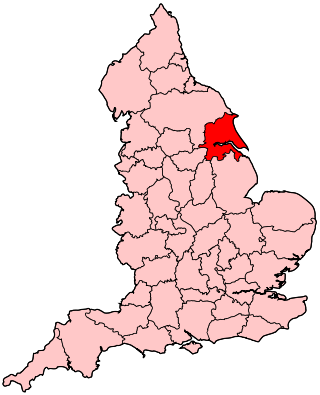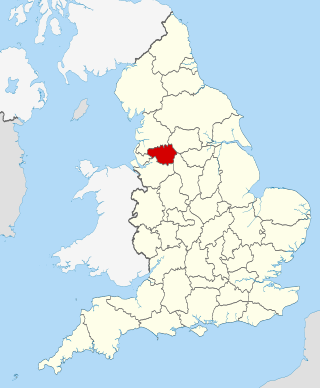
Metropolitan counties are a subdivision of England which were originally used for local government. There are six metropolitan counties: Greater Manchester, Merseyside, South Yorkshire, Tyne and Wear, West Midlands and West Yorkshire.

South Yorkshire is a ceremonial county in the Yorkshire and the Humber region of England. It borders North Yorkshire and West Yorkshire to the north, the East Riding of Yorkshire to the north-east, Lincolnshire to the east, Nottinghamshire to the south-east, and Derbyshire to the south and west. The largest settlement is the city of Sheffield.

West Yorkshire is a metropolitan and ceremonial county in the Yorkshire and the Humber region of England. It borders North Yorkshire to the north and east, South Yorkshire and Derbyshire to the south, Greater Manchester to the south-west, and Lancashire to the west. The city of Leeds is the largest settlement.

Humberside was a non-metropolitan and ceremonial county in Northern England from 1 April 1974 until 1 April 1996. It was composed of land from either side of the Humber, created from portions of the East Riding of Yorkshire, West Riding of Yorkshire, and the northern part of Lindsey, Lincolnshire. The county council's headquarters was County Hall at Beverley, inherited from East Riding County Council. Its largest settlement and only city was Kingston upon Hull. Other notable towns included Goole, Beverley, Scunthorpe, Grimsby, Cleethorpes and Bridlington. The county stretched from Wold Newton at its northern tip to a different Wold Newton at its southernmost point.

A metropolitan borough is a type of local government district in England. Created in 1974 by the Local Government Act 1972, metropolitan boroughs are defined in English law as metropolitan districts within metropolitan counties. All of the metropolitan districts have been granted or regranted royal charters giving them borough status. Metropolitan boroughs have been effectively unitary authority areas since the abolition of metropolitan county councils by the Local Government Act 1985. Metropolitan boroughs pool much of their authority in joint boards and other arrangements that cover whole metropolitan counties, such as Local enterprise partnerships and Combined authorities and combined county authorities, with most of the latter having a directly elected metropolitan mayor.

Local government in England broadly consists of three layers: civil parishes, local authorities, and regional authorities. Every part of England is governed by at least one local authority, but parish councils and regional authorities do not exist everywhere. In addition, there are 31 police and crime commissioners, four police, fire and crime commissioners, and ten national park authorities with local government responsibilities. Local government is not standardised across the country, with the last comprehensive reform taking place in 1974.
In the United Kingdom, passenger transport executives (PTEs) are local government bodies which are responsible for public transport within large urban areas. They are accountable to combined authorities, which were created between 2011 and 2016 and took the role of integrated transport authorities (ITAs). The PTEs have joined together to form the Urban Transport Group, in which Transport for London and Strathclyde Partnership for Transport also participate.

Birmingham, a city and metropolitan borough in the West Midlands, England, is the second-largest city in the United Kingdom.

The Local Government Act 1985 is an Act of Parliament in the United Kingdom. Its main effect was to abolish the six county councils of the metropolitan counties that had been set up in 1974, 11 years earlier, by the Local Government Act 1972, along with the Greater London Council that had been established in 1965. In their place many single purpose authorities known collectively as 'joint authorities' were established for fire service, police and passenger transport. An ad hoc education authority was established for Inner London and a planning authority for Greater London. The legislation permitted councils to form 'joint arrangements' for waste disposal and other services that they wished to provide together. Time-limited residuary bodies were created to dispose of the assets of the former authorities.

Leeds City Council is the local authority of the City of Leeds in West Yorkshire, England. Leeds has had a council since 1626, which has been reformed on numerous occasions. Since 1974 it has been a metropolitan borough council. It provides the majority local government services in the city. It is the second most populous local government district in the United Kingdom with approximately 800,000 inhabitants living within its area; only Birmingham City Council has more. Since 1 April 2014, it has been a constituent council of the West Yorkshire Combined Authority.

Greater Manchester Fire and Rescue Service (GMFRS) is the statutory emergency fire and rescue service for the metropolitan county of Greater Manchester, England. It is part of the Greater Manchester Combined Authority.

Lincolnshire Fire and Rescue (LFR) is the statutory fire and rescue service serving the non-metropolitan county of Lincolnshire in the East Midlands Region of England. This does not include North Lincolnshire and North East Lincolnshire, which are covered by Humberside Fire and Rescue Service.

The South Yorkshire County Council (SYCC) — also known as South Yorkshire Metropolitan County Council — was the top-tier local government authority for the metropolitan county of South Yorkshire from 1 April 1974 to 31 March 1986. A strategic authority, with responsibilities for roads, public transport, planning, emergency services and waste disposal, it was composed of 100 directly elected members drawn from the four metropolitan boroughs of South Yorkshire: Barnsley, Doncaster, Rotherham and Sheffield.

A combined authority (CA) is a type of local government institution introduced in England outside Greater London by the Local Democracy, Economic Development and Construction Act 2009. CAs are created voluntarily and allow a group of local authorities to pool appropriate responsibility and receive certain devolved functions from central government in order to deliver transport and economic policy more effectively over a wider area. In areas where local government is two-tier, both must participate in the combined authority.

The Greater Manchester Combined Authority (GMCA) is a combined authority for Greater Manchester, England. It was established on 1 April 2011 and consists of 11 members; 10 indirectly elected members, each a directly elected councillor from one of the ten metropolitan boroughs that comprise Greater Manchester, together with the directly elected Mayor of Greater Manchester. The authority derives most of its powers from the Local Government Act 2000 and Local Democracy, Economic Development and Construction Act 2009, and replaced a range of single-purpose joint boards and quangos to provide a formal administrative authority for Greater Manchester for the first time since the abolition of Greater Manchester County Council in 1986.

West Yorkshire County Council (WYCC) – also known as West Yorkshire Metropolitan County Council (WYMCC) – was the top-tier local government administrative body for West Yorkshire from 1974 to 1986. A strategic authority, with responsibilities for roads, public transport, planning, emergency services and waste disposal, it was composed of 88 directly elected members drawn from the five metropolitan boroughs of West Yorkshire. West Yorkshire County Council shared power with five lower-tier district councils, each of which directed local matters.

Wakefield Council, also known as the City of Wakefield Metropolitan District Council, is the local authority of the City of Wakefield in West Yorkshire, England. Wakefield has had a council since 1848, which has been reformed on several occasions. Since 1974 it has been a metropolitan borough council. It provides the majority of local government services in the city. The council has been a member of the West Yorkshire Combined Authority since 2014.

The South Yorkshire Mayoral Combined Authority is the combined authority for South Yorkshire in England, with powers over transport, economic development and regeneration. It covers a total area of 3,484 km2 (1,345 sq mi) with a population of 1.8 million. The four metropolitan boroughs of South Yorkshire – Sheffield, Rotherham, Doncaster and Barnsley – are full members of the authority, while the Derbyshire Dales, North East Derbyshire, Chesterfield and Bolsover districts of Derbyshire, and the Bassetlaw district of Nottinghamshire, are non-constituent members.

Rotherham Metropolitan Borough Council is the local authority of the Metropolitan Borough of Rotherham in South Yorkshire, England. It is a metropolitan borough council and provides the majority of local government services in the borough.


















